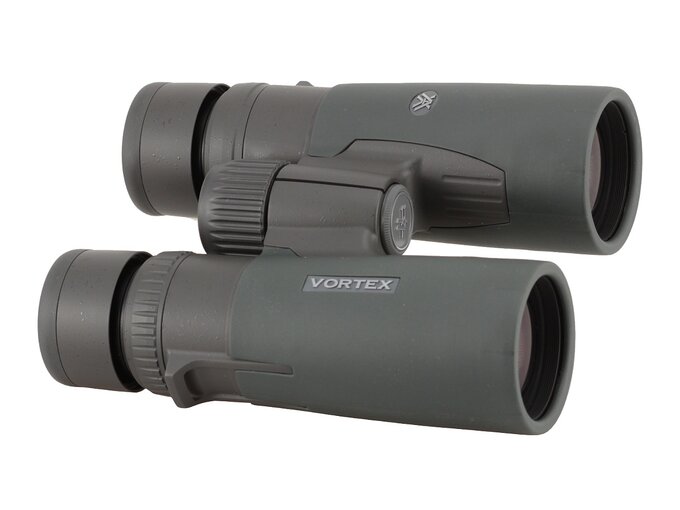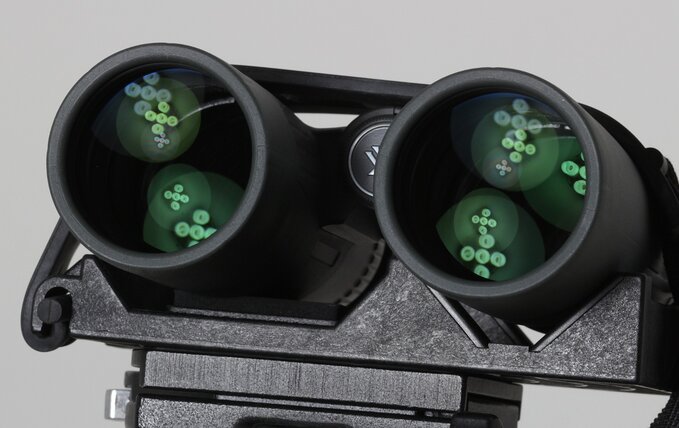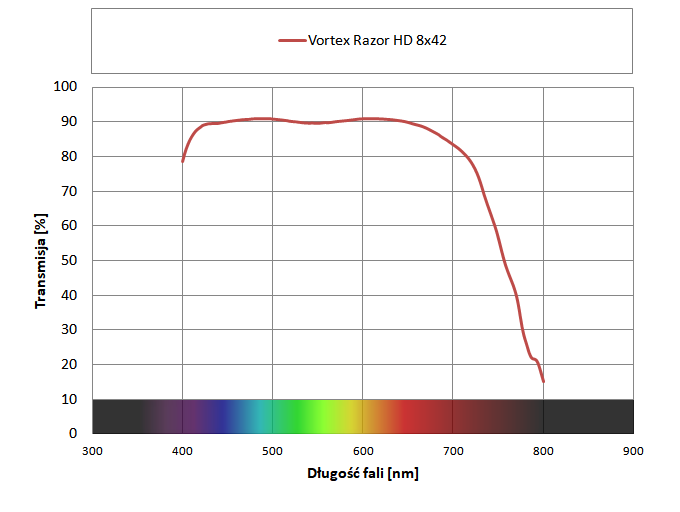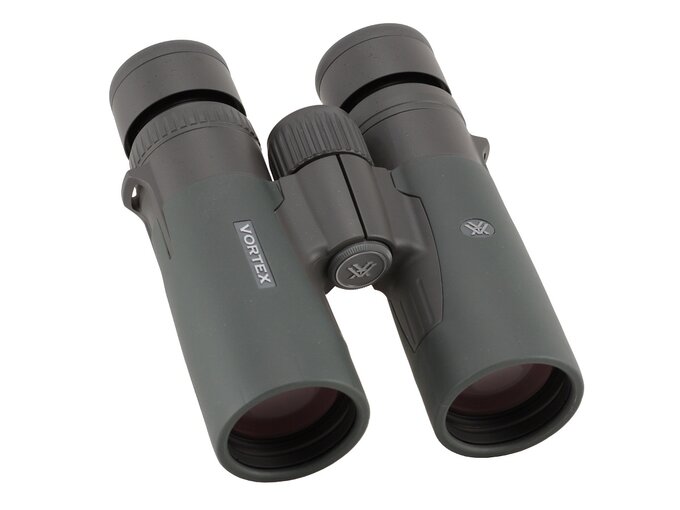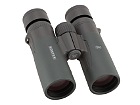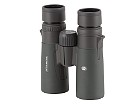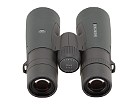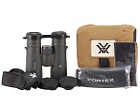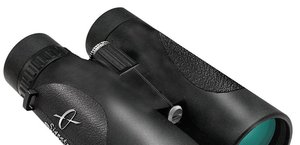| Real front lens diameter |
Left: 42.14+/-
0.05 mm
Right: 42.13+/-
0.05 mm
|
8 / 8.0 pkt |
| Real magnification |
7.93+/-
0.05x
|
3/3.0 |
| Transmission |
90.1+/-
1%
|
18/25.0 |
| Chromatic aberration |
Very low in the centre, a bit lower than medium on the edge. |
8/10.0 |
| Astigmatism |
Low. |
8.3/10.0 |
| Distortion |
Distance of the first curved line from the field of view centre compared to the field of view radius: 93% ± 3% |
10/10.0 |
| Coma |
Appears in a distance of 65-70% from the field centre and is on the borderline between medium and high values on the very edge. |
5.9/10.0 |
| Blurring at the edge of the FOV |
Blurr occurs in a distance of 85% ± 4% from the field of view centre. |
7/10.0 |
| Darkening at the edge the FOV |
Moderate. |
3.8/5.0 |
| Whiteness of the image |
Excellent, very flat transmission graph. Almost perfect colour rendering. |
4.9/5.0 |
| Collimation |
Perfect. |
5/5.0 |
| Internal reflections |
| Left: |
Right:
|
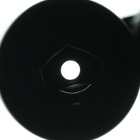 |
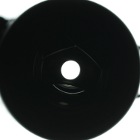 |
Distinct "drop" and a brighter arc under the exit pupil. The performance a bit weaker than in the 10x42 model. |
3.6/5.0 |
| Housing |
Solid but also shapely and very nice at the same time – the designers did a great job here because the pair of binoculars certainly catches your attention. A quite compact instrument for the 42 mm class. Comfortable to hold and to look through – everything fits immediately. Padded with good quality rubber that sticks perfectly well but can be slightly pulled out near the objectives. Rubberized eyecups with four detention stops. Produced in the Philipines. |
7.8/8.0 |
| Focusing |
A big and comfortable central wheel – it moves smoothly and is properly damped. Its focus throw amounts to an angle of about 570 deg. A ribbed dioptre correction ring that can be shifted is put on the right eyepiece. It moves the outer element. |
4.5/5.0 |
| Tripod |
A quite comfortable access. |
3/3.0 |
| Interpupilary distance |
from 54.7 to 75.3mm
|
5/6.0 |
| Closest focusing distance |
1.55 meters. |
2/2.0 |
| Eyepieces FOV |
Aparent field of view of 58.0 deg (simplified formula) and 53.7 deg (tangent formula). |
9/20.0 |
| Field of view |
Measured by us amounted to 7.31 ± 0.04 deg and was slightly narrower than declared in official specifications. |
5.5/8.0 |
| Quality of the interior of the barrels |
Inner tubes strongly ribbed, dark, and properly matted. Areas near prisms are dark but the cell they are set in is not covered by anything and gray. Some specks of dust. |
4/5.0 |
| Vignetting |
| Left: |
Right:
|
 |
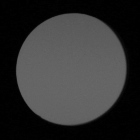 |
OL: 3.27%, OR: 4.61% |
3.5/8.0 |
| Prisms quality |
Good quality BaK-4. |
8/8.0 |
| Antireflection coatings |
Green-purple on objective lenses, greenish on the prisms, purple-green-yellow on the eyepieces. Low intensity. |
5/5.0 |
| Warranty [years] |
lifetime |
6/6.0 |
| Final result |
78.3%
|
148.8 / 190 pkt
|
| Econo result |
|
0pkt. |
Summary
Pros:
- shapely, solid and stylish casing made of magnesium composites,
- slight astigmatism,
- very low chromatic aberration,
- moderate brightness loss on the edge of the field,
- sharp image up to 85% of the field,
- practically invisible distortion,
- excellent colour rendering,
- high quality coatings,
- good quality prisms made of BaK-4 glass,
- sharp image already from 1.55 metres,
- lifetime warranty,
- sensibly dark areas near exit pupils,
- good blackening inside of the tubes.
Cons:
The times when you could buy a pair of binoculars from the best manufacturers for a sum of about 1000-1500 USD are definitely over. Now you have to spend definitely more than 2000 USD.
Still, it's worth remembering that a graph showing a corelation between the quality of optical instruments and their price is rather logarithmic than linear. At the beginning the quality increases very quickly with a jump of the price but on the other end of the spectrum just several percent of quality increase might cost you as much two times more.
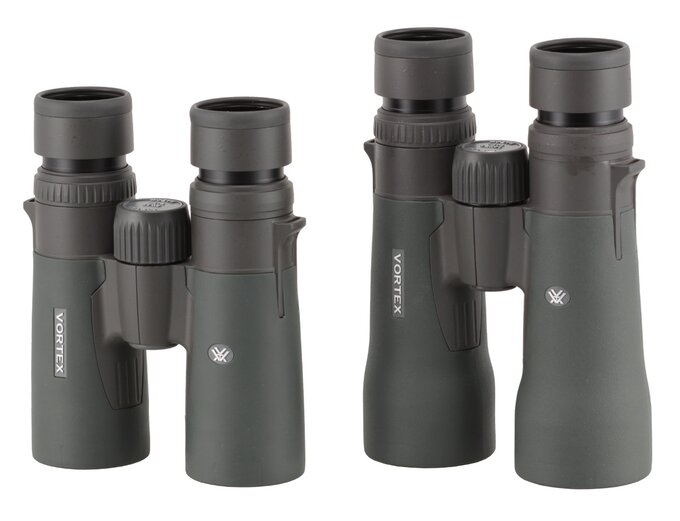
Vortex Razor HD 8x42 and Vortex Razor HD 10x50. |
That's why, if I had to look for a pair of binoculars that is just slightly weaker than the best products available on the market but doesn't have a budget-wrecking price tag I would focus on the 1000-1500 USD range. Such series as Meopta Meostar B1, Nikon Monarch HG, or Zeiss Conquest HD fit that price range and their price/quality ratio remains excellent. They are almost top-of-the-range devices but they can cost even two times less than the best instruments available on the market.
I don't doubt that the Razor HD series produced by Vortex belongs to that group as well. The result of the 8x42 model in our tests proves that it is able to compete with the best pairs of binoculars very effectively.
In fact, you get here everything you might expect from a top-of-the-range pair of binoculars: a solid, magnesium casing that is also very stylish, good optical properties, especially excellent antireflection coatings that are able to ensure you a very flat transmission graph with a level near 90% in the wide range of spectrum. As if it wasn't enough, you also get a very comfortable eye relief distance, amounting to 17.5 mm, and a possibility of focusing up from a distance of 1.55 meters.
What's more, the producers really made an effort to ensure that the binoculars are lightweight and handy. The Razor HD 8x42 weighs just 679 grams and it's a value even a tad lower than the one stated in the specifications. The length of the instrument reaches just 149 mm so when it comes to physical dimensions and the weight the Razor can compete with many bigger 8x32 models. For example the Zeiss Conquest HD 8x32 weighs 630 grams.
Striving to guarantee low weight and limited dimensions has its price, though; is the reason why the Razor HD 8x42 has one flaw. Small prisms cause distinct vignetting and you get truncated exit pupils as a result.
If you are determined to pick holes in the performance you can complain about a bit too narrow field of view, lagging behind that of other top-of-the-range instruments. The field of view of eyepieces should exceed 60 degrees and here you get a tad less, 58 degrees. Of course you don't feel any discomfort or an impression that you look through a keyhole but still the situation is far from the ease offered by an instrument with 60-70 deg eyepieces. Especially that the Razor HD 10x42, tested by us earlier, could offer eyepieces with an apparent field of view of 67 deg. The regress is clear here.
Still, these two flaws, mentioned by us just a moment ago, don't change our very high assessment of the Razor HD 8x42; it is able to repeat an equally perfect result of the Razor HD 10x42, tested by us before. If you are looking for an excellent, very solid pair of binoculars that will serve you for many years and looks like a million dollars and you don't want to spend a fortune on it, you definitely should take a closer look at the Razor HD series.


